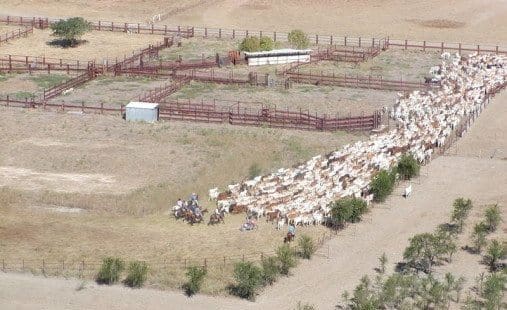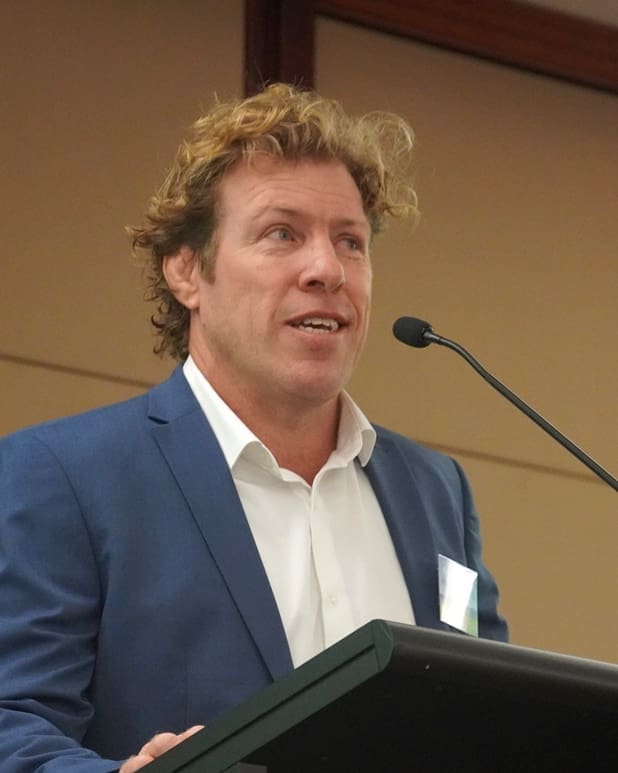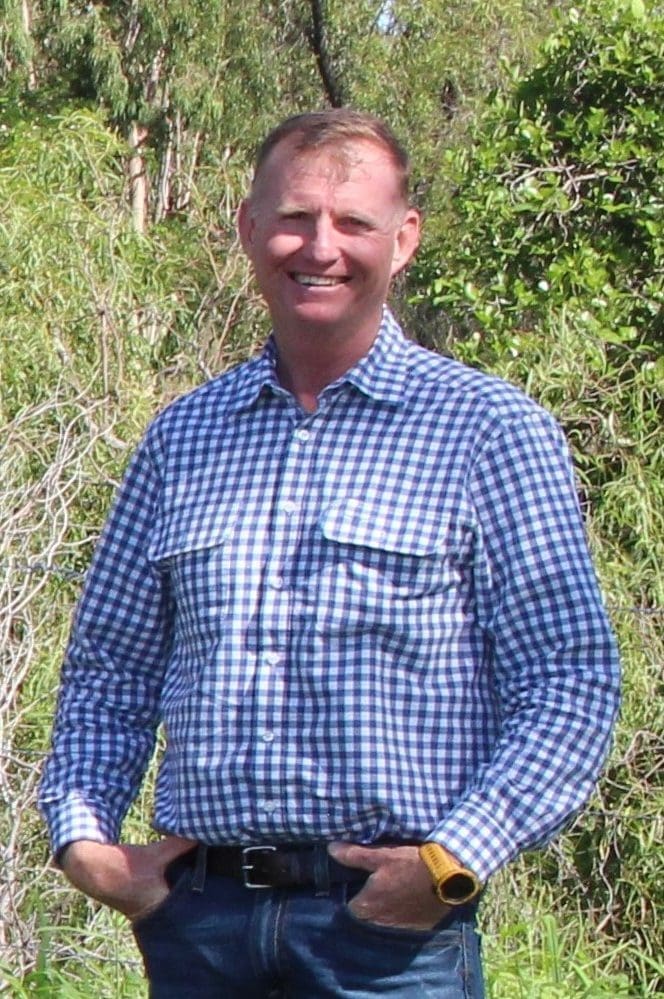
Brahman cattle in a set of yards on Benmara in the Northern Territory
IN recent years, prices paid for a number of pastoral leases in northern Australia have been difficult to comprehend. Were the disproportionately high values attributed solely or in part to ambitious productivity estimates?
In this week’s property review, buyers are being urged to put time into understanding what an asset can run in terms of livestock, to give them a clearer picture of potential value.
Frank Peacocke is Herron Todd White’s Darwin-based rural property valuer.
He suggests people who want to develop sustainable carrying capacity estimates in extensive grazing areas should try to apply a mix of proven historic carrying capacity rates for various country types in the district, combined with trialled and proven science-based research data for local country types.
“Published data relating to pasture growth modelling and utilisation rates on defined land systems (or land units), given a range of land conditions, is generally available for the dominant country types in a region,” Mr Peacocke said
“They are very useful benchmarks for optimal long-term stocking and can be mapped over a property, based on a selected appropriate grazing distance from available permanent and semi-permanent water points.”

Frank Peacocke HTW
Mr Peacocke said this information could be used to generate a grazing radius map for a property.
“This calculates the main productive area (MPV), as well as the potential carrying capacity for the balance of country.”
It was important to combine the above with the experience of local producers, expert opinions and grazing records where available (and appropriate), he said.
Mr Peacocke warned that determining carrying capacity also came with challenges.
“Often, vendors provide ‘back of the envelope’ stocking history, where land condition is sometimes difficult to accurately estimate and the impact of supplements may not be considered.”
He agreed that some sales might not stack-up on a dollar per productive unit basis ($/AE) when compared to other sales and value expectations generally prevailing in the region.
“It may come down to an over-estimation of what these properties can sustainably carry over the long-term, given their current development and land condition.”
“Some of the estimates of current carrying capacities associated with certain pastoral leases are more reflective of the average stocking rates after a run of well-above average seasons.”
“A long-term (say ten year) average comparison will also take into account the well-below average years, as is the case with the present big dry,” he said.
The Carbon Factor
Recently, the influence of carbon farming potential had featured in the NT pastoral property market.
The first sale where carbon farming potential reportedly influenced the price was Maryfield and Limbunya in September 2022 and then Ban Ban Springs in November 2022, Mr Peacocke said.
“Since then, there have been 11 station sales and only two have been influenced by carbon potential – Benmara (April 2023) and Conways (October 2023).”
He said all beast area values ($/AE) have shown steady increases over that time, but the carbon sales have shown the highest growth factor.
“Apart from Ban Ban Springs (which already had a carbon project in place), the carbon projects on the other properties were all registered well after the date they sold.”
“Just how much of that premium can be attributed to carbon potential requires a realistic assessment of the pastoral property exclusive of potential income from carbon and, for this, a realistic carrying capacity assessment is essential.”
In May 2023, the 451,200ha Benmara Station on the Barkly Tableland made $40 million in off-market deal (land only basis), described by some observers as ‘staggering’ in terms of both price and estimated carrying capacity.
With significant water and fencing infrastructure undertaken by the vendor during his seven year ownership, Benmara was offered with a suggested 20,000 head carrying capacity.
Several industry experts suggested to Beef Central that the 20,000 head carrying capacity must have been for a mixed herd, not an adult equivalent basis.
They claimed the country was probably capable of running between 13,000AE and 15,000AE, with significant potential to increase the carrying capacity upon further development of waters and fencing.
If that was the case, the sale price looked top-heavy. But are there other underlying factors causing confusion about the perceived high value and sustainable carrying capacity?
Even though there wasn’t a carbon project in place on Benmara at the time of sale, carbon was identified as a driving factor. Did this contribute to what was perceived as a high value, and if it returned to the market today, would it achieve a comparable price?
Earlier this year, at an HTW breakfast in Brisbane, Mr Peacocke compared the price paid for Benmara to the former S. Kidman station Brunchilly (incorporating Banka Banka East).
“In most respects, the blue-chip Brunchilly is far superior to Benmara and showed $2000/AE (for fenced and watered country/main productive area), however, Benmara showed $2050/AE (main productive area).”
Mr Peacocke said it should have been the other way around, and with a greater margin, and questioned whether the difference highlighted the carbon farming potential of Benmara above Brunchilly.
Then there is Maryfield and Limbunya Stations which are currently being advertised for sale, and where it is suggested a carbon project and sub-leased pastoral operation will operate hand-in-glove.
Mr Peacocke believes the imminent sale will be a litmus test.
“Will the income generated by HIR ACCUs (registered over both properties in April 2023) combined with rent from the sub-leasing producer (AAM Investment Group) provide the return required by the potential investor?”
Mr Peacocke said the rent would need to be realistic, as will the assessed carrying capacity of the project affected grazing country.
“If rents are set at a percentage of the purchase price (which might be at a premium over and above pastoral land values) and the producer has to co-exist with the carbon project (which is likely to have some impact on grazing productivity), will the producer be able to make enough to cover an inflated rent and still make a profit?”
Martin Pentecost, Grow Financial Group
Martin Pentecost from Central Queensland’s finance and agribusiness consultancy Grow Financial Group said some potential buyers, in particular overseas investors, engaged city-based consultants who had little or limited to no expertise in how grazing or farming properties operate.
He urged interested parties to obtain ‘ground truth’ about what they are being told.

Martin Pentecost
“In other words, get boots on the ground and look at the asset. Inspect a property you are considering purchasing and do your assessment just as you would for any other business. Engage with neighbours and local agents and ask them about long-term stocking rates and carrying capacities,” Mr Pentecost suggested.
He said If possible, potential buyers should look at herd records over a ten-year period.
“This will give a good cross-section of what numbers a property can run during good, bad and average seasons.”
“A vendor may offer a 1000 head carrying capacity but due to a good season, the property is flush with grass and can now run 1300 head for a limited period. By the end of the season, that available feed is gone and cattle numbers may be wound back to 600,” he said.
Mr Pentecost said carrying capacity should not be confused with stocking density – they are two different things.
“Stocking density (or rate) versus carrying capacity can vary wildly. If the season has been good, you can stock a place heavily for a short period to take advantage of the grass.”
Mr Pentecost said conversely, carrying capacity is about the country’s ability to provide the feed.
“It is determined by the land, the vegetation and soil. The manager determines the density. Carrying capacity is a balance between the long-term feed supply and the amount of feed consumed.”
He said in the light of high property prices and the current business environment (ie. interest rates, costs of production etc), producers needed to make sound business decisions based on return on investment.
“What we have seen in recent years has been phenomenal with Central Queensland land prices rising from $1000/ac to between $3000/ac and $4000/ac.”
Mr Pentecost said producers should put less emphasis on longer-term capital growth.
“Instead, they should take a more serious look at what a place earns and its capacity to service debt and generate revenue, because I don’t believe we will see the same levels of capital growth in our lifetime.”
Words of advice
When cattle stations in northern Australia are being bought and sold on their current carrying capacity, HTW’s Frank Peacocke recommends it is worth spending the time and the investment on appropriate due diligence to justify as best as possible, a reasonable long-term carrying capacity.
“Once the current carrying capacity is accurately assessed (ie. total AEs at current development), a producer can determine the sustainable size of the breeder herd and if a realistic breeder herd benchmark number can be set.”
He said this would ultimately determine the number of animals (or kilograms) sold off the station to generate the cash flow required to run the property, develop it further, earn a decent profit margin and pay the interest on the investment.
“The long-term carrying capacity benchmark will obviously be exceeded in above average seasons and will come in short for below average years, but there needs to be a sustainable long-term benchmark.”
‘Defendable’ carrying capacity assessments
Mr Peacocke urged prospective buyers to use someone experienced in ‘defendable’ carrying capacity assessments.
“It is critical the approach to carrying capacity assessment (particularly in terms of assumptions made) remains consistent between the properties analysed -either to buy, sell, rent or put a carbon project over.”
“If approaches chop and change and are inconsistent, the results (ie. $/AE for purchase or rent) will compound. There are some valuers with the necessary experience and also well regarded agri-scientists from both the private and government sectors,” he said.

Great comments, Frank, and I agree with the views on carrying capacity. It is not a wild guess and can be calculated by considering:
– The land capacity to grow dry matter (grass),
– The long-term average annual rainfall,
– Level of land development,
– Competent and prudent management,
– Beef cattle enterprise.
On the carbon piece, prudent purchases don’t pay for potential. Only established income streams (accu’s) have a net present value.
Trying to get relevant and documented stocking rates is extremely difficult. Great article but unfortunately too much property ‘value’ relies on the greater fool theory.
Hallelujah!